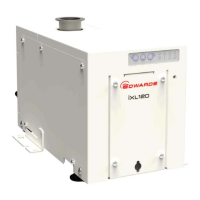A591-40-880 Issue A
Page 16 © Edwards Limited 2012. All rights reserved.
Edwards and the Edwards logo are trademarks of Edwards Limited.
Installation
Ensure that all components in the vacuum pipeline have a maximum pressure rating which is greater than the
highest pressure that can be generated in your system.
Incorporate flexible pipelines in the vacuum pipeline to reduce the transmission of vibration and to prevent
loading of coupling-joints. We recommend that you use Edwards braided flexible pipelines for exhaust
connection.
Adequately support vacuum/exhaust pipelines to prevent the transmission of stress to pipeline
coupling-joints.
Incorporate a pressure gauge in the inlet pipeline, as an aid to determining that the iXL120 system operates
correctly.
You must be able to isolate the iXL120 system inlet from the atmosphere and from your vacuum system if you
have pumped or produced corrosive chemicals.
Refer to Figure 2, items 18 and 5. Use the following procedure to connect the inlet and exhaust of the iXL120 system
to your vacuum inlet and exhaust pipeline:
1. Remove the blanking plate from the inlet of the iXL120 system.
2. Use the O-ring and NW50 Clamping ring supplied to connect the inlet-flange (Figure 2, item 18) of the iXL120
system to your vacuum system.
3.5 Leak test the iXL120 system
Note: If you need further information on leak-testing, contact Edwards.
3.6 Connect the nitrogen supply
3.6.1 Flammable/pyrophoric materials
The iXL120 is not suitable for use with potentially flammable or pyrophoric materials.
When flammable or pyrophoric materials are present within the pump there may be additional risks that the user is
responsible for assessing and managing as part of the entire Process Tool installation. The severity of the risks and
the necessary control measures will depend largely on whether the tool exhaust is in the flammable region, if this is
part of normal Process Tool operation, or if it might only occur under rare conditions. The additional risks arise
because all dry pumps must be considered a potential source of ignition owing to the heat of compression, or possibly
friction. If ignition occurs then the following may happen:
High pressures could occur within the pump and may not be contained
A flame front could travel back up the foreline
A flame front could travel downstream from the exhaust of the pump.
Industry best practice suggests that the following measures will reduce the risks of pumping flammable mixtures and
pyrophoric materials, but it is the user's responsibility to carry out a risk assessment and take appropriate measures:
Leak test the system after installation and seal any leaks found to prevent leakage of dangerous
substances out of the system and leakage of air into the system.
You must obey the instructions and take note of any precautions given below to ensure that
pumped gases do not enter their flammable ranges.

